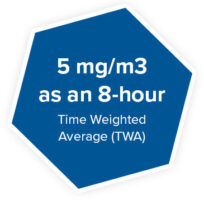THE COMPLETE GUIDE TO WELDING
FUME EXTRACTION SYSTEMS:
HOW (AND WHY) TO KEEP YOUR FACILITY AIR CLEAN AND SAFE
CHAPTER TWO: REGULATORY REQUIREMENTS FOR WELD FUME EXPOSURE
In designing a weld fume mitigation strategy, it is important to understand the goals you want to set in terms of weld fume exposure and overall indoor air quality (IAQ). This starts with knowing the regulatory limits for exposure to weld fume. Meeting the regulatory standard for worker exposure to weld fume and specific toxic substances found in the fume is a legal requirement for all employers. However, facilities may wish to set their own goals for air quality and worker exposure that go beyond the legal minimums. More stringent standards set by organizations such as NIOSH and ACGIH will create a safer, healthier and more pleasant working environment for welders.

What are the exposure limits for weld fumes?
In the U.S., the Occupational Safety and Health Administration (OSHA) has set a Permissible Exposure Limit (PEL) for total weld fume concentration of 5 mg/m3 when welding mild steel, iron or aluminum. It also has set (usually much lower) exposure limits for individual compounds and elements commonly found in weld fumes, such as manganese, hexavalent chromium, nickel, lead and zinc. Employers are responsible for ensuring that worker exposure does not exceed the exposure limit over a shift. OSHA PELs carry the weight of law in the United States and can be enforced; exceeding these limits may expose employers to fines and sanctions. Employers should also be aware of recommended exposure limits set by industry organizations as best practices; these may be lower than the OSHA-regulated exposure limit.
What are ACGIH threshold limit values (TLVs) for weld fumes?
The American Congress of Governmental Industrial Hygienists sets recommended threshold limit values (TLVs) based on an 8-hour TWA. ACGIH has set an 8-hour TWA of 5 mg/m3 for welding fumes that are generated by the manual metal arc or oxy-acetylene welding of iron, mild steel, or aluminum; this limit is under study for 2023. ACGIH has also set ceiling limit recommendations for many individual weld fume constituents (see chart below). ACGIH TLVs and ceiling limits do not carry the force of law but are considered to be best practices in industrial hygiene. These guidelines are set based on scientific research on the health impacts of exposures without consideration of technical feasibility; they are often more stringent than the OSHA PEL.
What are NIOSH recommended exposure limits (RELs) for weld fumes?
The National Institute of Occupational Safety and Health sets recommended exposure limits (RELs) for welding fumes, total particulates and individual weld fume constituents. The REL for total weld fume exposure is 5 mg/m3 as an 8-hour time weighted average. They have also set ceiling limit recommendations for many individual weld fume constituents (see chart below). NIOSH RELs are not directly enforceable but are often used as guidelines by OSHA and other regulatory bodies when setting standards. NIOSH guidelines can be found in their “NIOSH Pocket Guide to Chemical Hazards.”

How does weld fume composition impact exposure limits?
It is important to understand the composition of your weld fume when setting exposure levels. Weld fume composition will vary depending on the base metal, consumables, and any coatings or lubricants found on the base metal. For example, welding stainless steel produces dangerous hexavalent chromium compounds (chromium VI) not typically found when welding other materials. Welding fumes from galvanized metals, on the other hand, contain zinc oxides and, often, lead. For this reason, it is not sufficient to set an exposure limit for “weld fume” in general without understanding the constituents of the fume and their relative levels of toxicity. If you are not sure of the chemical composition of your weld fume, laboratory testing may be advised.
EXPOSURE LIMITS FOR SELECTED WELD FUME COMPONENTS, GENERAL INDUSTRY
| BASE METAL | OSHA PEL | NIOSH REL | ACGIH TWA |
|---|---|---|---|
| Chromium VI | 0.005 mg/m3 | 0.0002 mg/m3 | 0.0002 mg/m3 |
| Manganese Fume | 5 mg/m3 | 1 mg/m3 | 0.02 mg/m3 |
| Cobalt | 0.1 mg/m3 | 0.05 mg/m3 | 0.02 mg/m3 |
| Lead | 0.05 mg/m3 | 0.05 mg/m3 | 0.05 mg/m3 |
| Nickel | 1 mg/m3 | 0.015 mg/m3 | 0.02 mg/m3 |
| Cadmium | 0.005 mg/m3 | 0.002 mg/m3 | 0.002 mg/m3 |
| Aluminum dust (respirable fraction) | 5 mg/m3 | 5 mg/m3 | 1 mg/m3 |
| Titanium dioxide (total dust) | 15 mg/m3 | 1.4 mg/m3 (fine) or 0.3 mg/m3 (ultrafine) | 10 mg/m3 |
From OSHA.gov Permissible Exposure Limits – Annotated Table Z-1, January 2022. Check for updated national and local regulations and NIOSH and ACGIH guidelines when creating your facility plan.
What are weld fume occupational exposure limits in Canada?
In Canada, exposure limits are set by local jurisdiction (province or territory). Most jurisdictions do not have an occupational exposure limit (OEL) for total weld fumes; OELs are set for specific constituents of weld fume such as chromium, manganese or lead. Many jurisdictions in Canada follow the ACGIH limits for weld fume constituents. Some jurisdictions use the ACGIH guidelines for Particulates Not Otherwise Specified (PNOS) for total weld fume exposure. These limits are 10 mg/m3 for total airborne concentration and 3 mg/m3 for the respirable fraction (defined as ≤ 4µm).
TALK TO AN EXPERT
Want to learn more? Talk to a dust, mist and fume expert today by filling out the fields below.







